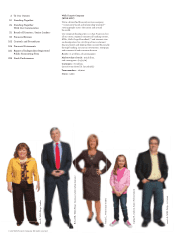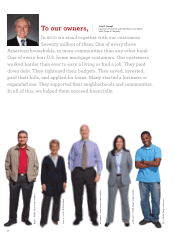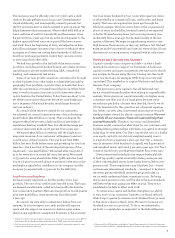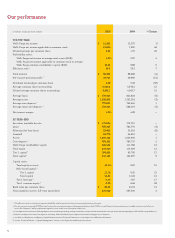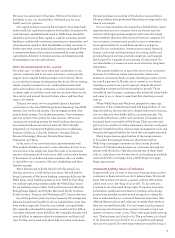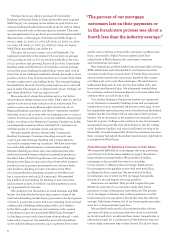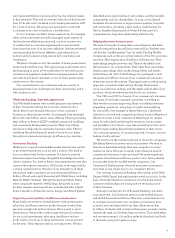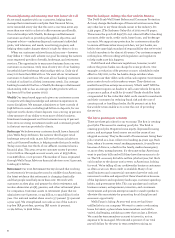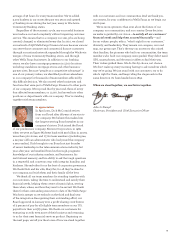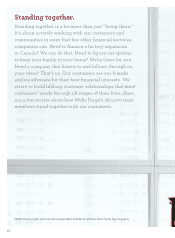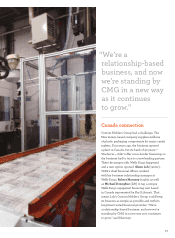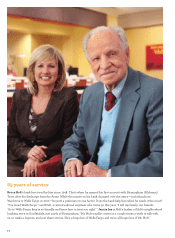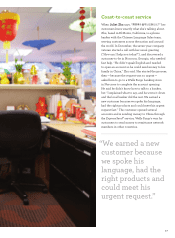Wells Fargo 2010 Annual Report Download - page 10
Download and view the complete annual report
Please find page 10 of the 2010 Wells Fargo annual report below. You can navigate through the pages in the report by either clicking on the pages listed below, or by using the keyword search tool below to find specific information within the annual report.
Financial planning and investing: One visit doesn’t do it all
As we stand together with our customers, helping them
manage their investments and plan their financial future,
we’re reminded every day that this isn’t a one-time event any
more than one visit to a doctor’s oce ensures good health.
Our relationships with Wealth, Brokerage and Retirement
customers are built on providing thoughtful, objective, and
frequent advice—understanding each customer’s individual
goals, risk tolerance, and needs, monitoring progress, and
helping them make changes when it’s right for them to doso.
When our customers achieve financial success—however
they define it—then we’ll achieve our goal: becoming the nation’s
most respected provider of wealth, brokerage, and retirement
services. The opportunity to earn more business from our own
customers is enormous. Only nine of every 100 of our banking
households have brokerage relationships with us. Only six of
every 100 have their IRA with us. We want all our investment
customers to bank with us. We want all our banking customers
to think of us first for all their investment needs. Our average
banking household that has a Wealth, Brokerage or Retirement
relationship with us has an average of 9.80products with us
(upfrom 9.67 in first quarter2010).
Wealth Our team-based approach gives our customers access
to experts with deep knowledge and extensive experience in
many disciplines. We manage, administer, or have custody of
$198billion in assets, including $48billion in deposits, for our
high-net-worth clients. Client deposits rose a strong 13percent,
a key measure of our ability to earn more of their business.
Investment management and trust revenue was up 11percent
from 2009 on strong investment results and continued growth
in the trust services provided toclients.
Brokerage We believe every customer should have a financial
plan. WellsFargo Advisors, the nation’s third-largest retail
brokerage network with 15,200 full-service financial advisors
and 4,400 licensed bankers, is helping make that goal a reality.
Today, more than two-thirds of our auent customers have a
financial plan. This year, we grew customer assets 6percent
to $1.2trillion. Managed-account assets, now at $235billion,
rose $38billion, or 20percent. The number of loans originated
through WellsFargo Advisors financial advisors rose 71percent,
totaling $7.2billion.
Retirement Our 2010 Retirement Survey showed that working
in retirement is becoming the norm for middle-class Americans,
the latest evidence that retirement is changing drastically
and that people need help more than ever. We work with
customers as they plan and prepare for their retirement, and
we also administer 401(k), pension, and other retirement plans
for companies. Customer assets in retirement plans that we
administer rose 6percent, or $14billion, to $231billion for the
year. Our national market share rose to 3.7percent (3.1percent
a yearago). We strengthened our rank as one of the nation’s
top-five IRA providers, growing IRA assets 10percent,
or $24billion, to $266billion.
Now the hard part: Making rules that work for America
The Dodd-Frank Wall Street Reform and Consumer Protection
Act may change the landscape of financial services more than
any other law in my three-decade career in the industry. It’s
2,319 pages. (TheSarbanes-Oxley Act of 2002 was 66 pages.
Those were the good olddays!) Its 240 rules will aect checking
accounts, debit cards, credit cards, home loans, and brokerage
accounts. We support any protection for customers nationally
to ensure all financial services providers, not just banks, are
held to the same high standard of responsibility that we’ve tried
to hold ourselves to for almost 160years. Our customers expect
nothing less. We’re working with legislators and regulators
to help make sure thishappens.
Dodd-Frank and other new regulations, however, would
reduce the prices banks can charge for some products. One
example: a reduction of 80percent or more, scheduled to take
eect in July 2011, in the fee banks charge retailers when
customers use their debit cards at the cash register. Government
price controls such as this make no sense. They distort our
market-based, free-enterprise economy. What’s next? Will the
government require car dealers to sell a new vehicle for $5,000
or grocers a gallon of milk for 50cents? Banks should be fairly
compensated for the value that debit cards create for merchants
and their customers by reducing fraud risk and the cost of
carrying cash or handling checks. An 80percent cut in this
fee wouldn’t even enable us to cover the cost of providing
the service.
The key to growing our economy
There are three priorities for our economy. The first is creating
good jobs. The second is creating good jobs. The third is
creating good jobs. Negative home equity, depressed housing
prices, and mortgage foreclosures are not the cause of our
sluggish economy. They’re the result of homeowners losing their
jobs. I started as a loan collector in banking 34years ago. Back
then, when a borrower wasn’t making payments, it usually was
because of divorce, a death in the family, medical emergency
or, most often, unemployment. It’s the same today. Americans
want to pay their bills and will if they have the resources to do
so. The U.S. economy did add a million jobs last year, but that’s
cold comfort to the almost one in every 11 Americans looking
for work. We’re telling all our creditworthy business customers
as often as we can: More credit is available. Many of our
small business and commercial customers have the cash and
resources to rehire and expand, but there’s hesitation because
of the legislative and regulatory landscape, customer spending
habits, and government debt. This can paralyze and confuse
business owners, entrepreneurs, investors, and consumers.
Government and private enterprise need to stand together to
alleviate this uncertainty by promoting fiscal discipline and
economic opportunity.
WellsFargo is hiring. At year-end 2010, we had 6,500
unfilled jobs in our company. We want to create a welcoming
home for talent, a place where team members can build a
varied, challenging, satisfying career that can last a lifetime.
Weconsider team members an asset to invest in, not an
expense to be managed. We invested 3percent of our total
payroll dollars for the year in team member training, an


